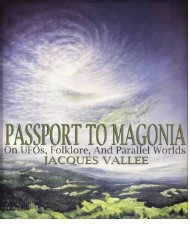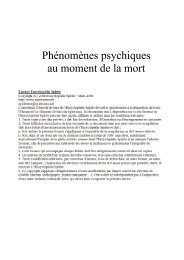extraordinary%20encounters
extraordinary%20encounters
extraordinary%20encounters
Create successful ePaper yourself
Turn your PDF publications into a flip-book with our unique Google optimized e-Paper software.
182 Mount Shasta<br />
A nineteenth-century engraving of Mount Shasta, California, the scene of occult legends from far back in the past (Library<br />
of Congress)<br />
entity named Phylos the Tibetan had dictated<br />
to him. In fact, when the novel was published<br />
in 1899, Phylos, not Oliver, was identified as<br />
the author. Phylos said he had experienced<br />
several incarnations, including one in Atlantis<br />
and another on Venus. In his most recent one,<br />
during the mid-century California gold rush,<br />
he (“he” being Walter Pierson, the name he<br />
held during that lifetime) met Quong, a Chinese<br />
man. Quong, a knower of mystical secrets,<br />
led Pierson into Shasta via a hidden tunnel.<br />
Inside the mountain they found huge<br />
chambers and treasures belonging to a secret<br />
brotherhood of advanced beings who had<br />
lived there for a very long time, devoting<br />
themselves to humanity’s spiritual betterment.<br />
In his astral body, Pierson traveled to Venus,<br />
where he learned many secrets; he also learned<br />
of his previous lives. Once enlightened, he<br />
was rechristened Phylos and became a<br />
guardian of the cosmos. A modern chronicler<br />
remarks that the “Tibetan” part of his title<br />
“seems to have been added for Mystery’s sake”<br />
(Kafton-Minkel, 1989).<br />
Oliver’s novel owed much of its inspiration<br />
to Madame Blavatsky’s theological writings<br />
and to works of mystical fantasy such as Edward<br />
Bulwer-Lytton’s Zanoni: A Rosicrucian<br />
Tale and Marie Corelli’s A Romance of Two<br />
Worlds. It was original, however, in setting a<br />
secret civilization within Mount Shasta. The<br />
next writer to do so, Harvey Spencer Lewis<br />
(writing as “Wishar C. Cerve”), identified the<br />
inhabitants as survivors of Lemuria, the Pacific<br />
Ocean’s version of Atlantis. According to<br />
Lewis’s Lemuria: Lost Continent of the Pacific<br />
(1931), when Lemuria split and sank, its east<br />
coast crashed into part of North America’s<br />
west coast to become the states of Washington,<br />
Oregon, and California. Many of the surviving<br />
Lemurians took up residence inside<br />
Shasta.<br />
Lewis claimed that persons living near<br />
Shasta occasionally encountered distinguished-looking<br />
men in white robes as they<br />
walked out of the forest. Sometimes these beings,<br />
who stood seven feet tall, did business in<br />
local stores, using gold nuggets to make their





